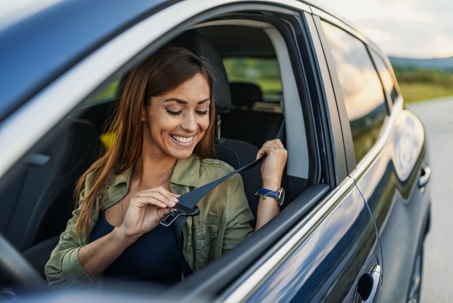Driving is a part of nearly everyone’s daily life. Because of this, we often go into autopilot mode behind the wheel. Many of us have learned safe driving techniques over the years that are ingrained in our minds and our actions. Well, our team at Wood Law Firm LLP is here to make you rethink some of the practices that you consider to be safe driving practices. Let’s discuss some common myths and misconceptions about how to best stay safe on the road.
Myth Number One: Hands at 10 and 2
Have you heard that you are supposed to keep your hands at the 10 o’clock and 2 o’clock positions on your steering wheel? Admittedly, many drivers don’t do this. What you may not know is that you may be better off ignoring this hand placement advice!
Keeping your hands at 10 and 2 also put your hands in the direct path of the steering wheel airbags. Upon impact, those airbags may deploy and aggressively shove your hands and arms backwards. This can lead to serious bruising, straining, or even bone fractures.
Instead, it is safer to keep your hands at the 9 o’clock and 3 o’clock positions.
Myth Number Two: Hands-Free Devices Are Safe To Use While Driving
Many states have enacted laws preventing drivers from using handheld devices while operating a vehicle. Instead, drivers are allowed to talk on speaker phones or use their car bluetooth. However, this can also be distracting and dangerous. Talking or using hands-free devices still takes the driver’s cognitive focus away from the road and traffic around them. This slows their reaction time should any obstacles come out of nowhere.
While hands-free devices are safer than handheld devices, you should try to refrain from using any while your car is in motion as there is still a safety risk.
Myth Number Three: Driving After One or Two Alcoholic Drinks is Fine
One or two drinks is standard for a lot of people, and therefore many individuals feel comfortable driving home with a bit of alcohol in their system as long as they are under the legal limit. However, even a small amount of alcohol can impair a driver’s mental and physical capabilities.
After just one alcoholic drink, a driver may experience:
- Lowered inhibitions
- Drowsiness
- Nausea
- Loss of coordination
- Difficulty making decisions
If you have had anything alcoholic to drink, it’s always safest to get a sober ride home.
Myth Number Four: The Bigger The Vehicle, The Safer
In some respects, this is true, like with crash protection. However, it’s also important to point out the ways that large vehicles come with their own safety risks. One of the most important things to note is that large vehicles take longer to reach a complete stop, especially trucks and tractor trailers. If you drive a large vehicle, be sure to account for the time needed to slow your vehicle down. If you are driving near large vehicles, keep a safe distance between you in case you need to slow down.
Additionally, large vehicles may have larger or more blind spots. If you are driving a larger vehicle, be extremely observant when turning or switching lanes.
Myth Number Five: Seatbelts Are Only Necessary In the Front Seats
This is definitely not true! Everyone should buckle up; seatbelts save the lives of passengers in all car positions. Even in the back seat, passengers in high speed crashes could go through the windshield and suffer serious injuries. In fact, the fatality risk for passengers who are not seatbelted in the back seat is 8x higher than for those that are buckled up.
While you may feel safer in the back seat, you never know what you could be involved in. Always take the extra few seconds to fasten your seat belt.

